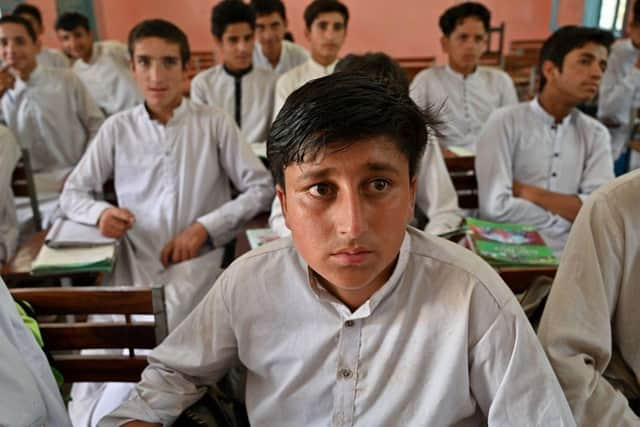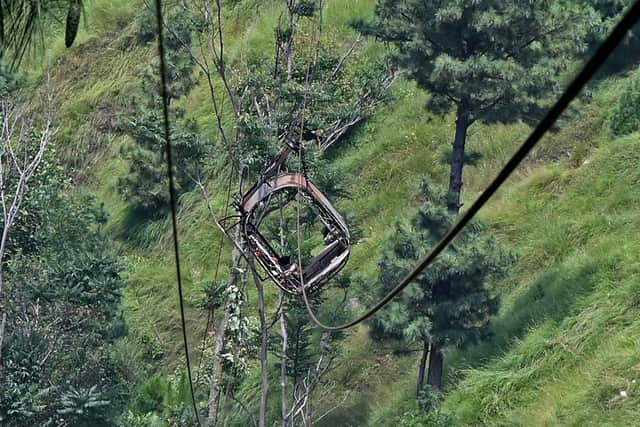Pakistan chair lift: Why does Pakistan have a vast network of homemade cable cars?
They have been described as “private” cable cars, which means they are not built and operated by the state. But, in reality, they are often home-made, from old car parts and scrap metal by local villagers.
Now Pakistan’s government has ordered an inspection of all privately-run cable cars in the country following this week’s rescue of eight people from a dangling chair lift after the cables snapped.
Advertisement
Hide AdAdvertisement
Hide AdThe network of private cable cars in Pakistan is vast and generally undocumented. The chair lifts are usually built by people in local villages in a bid to ease laborious journeys across valleys and rivers in regions where there is little or no transport network.


In Khyber Pakhtunkhwa, where the six schoolchildren and two adults were brought to safety by zip wire specialists, the cable car cut the journey time from the village of Jangri to the local school in Batangi from two hours to just four minutes.
Cable car owner Gul Zareen has been arrested on multiple charges, including endangering valuable lives and negligence.
Images available online of chair lifts and cable cars across Pakistan range from the modern, gondola-style cars and chair lifts used in European ski resorts, to a simple square of plastic suspended on four chains. Others used across the country include wooden bench seats and, in the case of the lift in Khyber Pakhtunkhwa, a wooden cage structure with rickety doors. Few have safety bars or are enclosed.
The cost of travelling on the homemade lifts is negligible – as cheap as 10 rupees (5p) per journey – in a country where the average wage is around £226 a month.


Mohabbat Shah, who lives close to the chairlift involved in this week’s accident, said locals were willing to risk the dangerous journey as they did not have many other ways travelling to key services.
He said there had never been an accident on the route before.
“We pay only 10 rupees per person on a one-way trip,” he said. “If we book a cab, this will cost up to 2,000 rupees (£18.91).”
Advertisement
Hide AdAdvertisement
Hide AdHowever, the convenient transport comes at a cost. Accidents – and even deaths – are common occurrences in Pakistan and often go unreported in the international media.
In 2017, 11 people, including three teenagers, died after a wire carrying a homemade cable car snapped in the village of Chara Pani. The improvised chair lift was strung between two mountains in Hazara division of Khyber-Pakhtunkhwa province, which local villagers used to cross the river underneath.
That tragedy came just weeks after four people drowned when a chairlift broke in the Diamer district of Gilgit-Baltistan.
On a single day in June, in Pakistan’s Swat Valley, a woman and her four-month-old son drowned after falling from a chair lift into a river. Local media reported the child had slipped from her grasp and the woman had jumped in after him. Meanwhile, separate reports said a woman and her five-year-old daughter had also plummeted to their deaths into a river, after the wire on a cable car snapped. It is not clear whether the incidents involved the same cable car route.
Dr Azra Meadows, of the Scottish Pakistani Association at the University of Glasgow, said the network of cable cars was critical to villagers to carry out their daily lives.
She said: “It was a miracle that they [the children in Khyber Pakhtunkhwa) were saved. In a lot of these cases, the cable cars are set up by villagers and are very rickety. But the journeys by road can be extremely long and difficult in rural Pakistan, especially in the mountain areas.
"These children needed to go to school, which is important, as they would not have a school in their village and didn’t have much choice as to how to get there. The network is vital, but also very dangerous.”
Across Pakistan, cable cars are used not only for transport, but – as in many other countries – as a tourist attraction. However, even those operated for leisure have come under criticism from users.
Advertisement
Hide AdAdvertisement
Hide AdOne man, writing in a TripAdvisor review, warned of “negligence” at one major cable car route, which takes tourists to the top of a mountain to experience the views.
"Though the cables are unsecured due to poor maintenance and negligence [but] you must visit for a life time experience,” he wrote. “The sight seeing/view is adorable. Do accompany your kids and ensure their safety. As there had been minor accidents in past.”
The youngsters who survived the ordeal have spoken of their fear while suspended in the air for 15 hours.
"Some of the children were so frustrated and were considering to jump down, but the elder passenger gave us confidence," said 15-year-old Rizwan Ullah, who returned to school the next day, walking two hours from his village.
"When the cable car was twisting, we were terrified and we started reciting the Koran and gave confidence to each other not to jump down."
Eighteen-year-old Muhammad, who has just started his final year of high school, said he felt as if he had been given "a second life".
"It was the most terrifying time of my life,” he said. “I forgot everything, but my mother. I thought only of my mother.
"When I reached my home, she was waiting for me at the gate. We hugged each other, she kissed me and we were in tears. It was very emotional for both of us.
Advertisement
Hide AdAdvertisement
Hide AdPakistan’s caretaker prime minister Anwaar ul Haq Kakar said: “I have also directed the authorities to conduct safety inspections of all such private chair lifts and ensure that they are safe to operate.”
Comments
Want to join the conversation? Please or to comment on this article.
